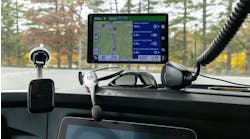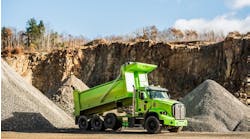A fleet's success has always depended on the uptime of its assets. As challenges mount and resources dwindle, the very survival of a fleet now rests on its ability to leverage data and connectivity tools. Telematics solution provider Samsara has made that easier with several new data-driven additions to its open-source Connected Operations Cloud.
The new features announced at Samsara's Beyond '23 user conference in Austin, Texas, on June 22 range from improving driver safety to optimizing maintenance operations, and were all developed with one goal: Helping Samsara users and partners attack the transportation industry's digital transformation head-on.
"[Samsara's] recent State of Connected Operations Report shows that organizations that have access to actionable data do a better job of retaining and engaging employees," noted Jeff Hausman, Samsara's chief product officer.
The report surveyed 1,500 business leaders in critical sectors across nine countries and revealed that 90% believe "having accurate, real-time operational data is critical to decision-making in 2023."
And by 2024, 84% of leaders plan to use generative AI to modernize operations, while 91% plan to involve automation. More than half are using or plan to use autonomous vehicles and/or equipment this year.
See also: Samsara launches tools focused on sustainable fleets
This is what the captains of industry will be using to navigate their businesses' futures and trawl for even more revenue. To keep from sinking in their wake, smaller fleets must adopt the same mentality and continuously improve.
And the digital tools that Samsara and other telematics providers offer to connect operations aim to do just that.
"With ongoing labor shortages and the next generation of the workforce demanding digital tools, we are helping make these jobs easier, safer, and more efficient," said Sanjit Biswas, CEO and co-founder of Samsara. "The next wave of digital transformation is happening now."
Samsara's wave of new tools
Virtual Coach: A real-time in-cab coaching aid that immediately alerts drivers to risky behavior such as harsh braking or speeding.
HD Camera Connector: Upgrades Samsara's AI-enabled dash-cam solutions to allow for up to four side, rear, and interior high-definition vehicle cameras to the Connected Operations Cloud. Video can be integrated with driver coaching apps to improve safety metrics and exonerate drivers in accidents where they are not at fault.
Connected Forms: An evolution of a typical electronic driver vehicle inspection report, these digital forms serve as paperless checklists for various workers, such as repair technicians, accessible via mobile devices. The real-time data can then drive process improvements and more efficient operations.
Smart Trailer and Asset Tracking solutions: Answers the question, "Dude, where's my trailer?" by providing the exact asset location, especially valuable if an asset is lost or stolen. This also speeds up the time it takes to prepare assets for work or service while also unlocking utilization and temperature data (for cold chain assets).
Data Connectors: Funnels disconnected third-party data into one place to improve business applications and workflows via new data connectors, including Fivetran, Kafka, and Power BI. Samsara has partnered with 240 technology companies to integrate their data feeds into the telematics platform.
Mobile Experience Management (MEM): Synchronizes a worker's Android mobile device to the back office to offer remote training and live troubleshooting while also allowing management to reduce distractions by locking certain features such as notifications during "focus time."
Turning data into action
Samsara works with tens of thousands of customers, accumulating 1.9 billion trips yearly and generating 6 trillion data points, Biswas noted. And that massive amount of data was crucial to developing these new products and, ideally, helping customers modernize their operations to improve safety, efficiency, and sustainability.
And the industry is at a stage where fleets need major assistance from artificial intelligence tools to leverage the data.
"You can't make sense of 6 trillion data points on your own," Biswas said. "You need help from the computer to go surface those insights."
Managers must not lose sight of what the data is supposed to do: enable workers to enact the necessary changes. While addressing the crowd on the innovation rollout, Hausman asserted: "Data can inform, but people transform."
See also: Four ways fleet managers can avoid data overload
According to Samsara data, they have already.
One of the more impressive success stories was at U.S. Logistics. The final-mile logistics fleet has 570 power units and 1,600 drivers and warehouse workers across 19 terminals. Needing to improve on safety to ensure they could meet customer demand, the fleet implemented the MEM tool to limit the number of distractions their drivers had by blocking non-driving related apps when the truck reached a certain speed. What was currently on a driver's company-provided smart device was also visible to fleet managers, discouraging misuse. U.S. Logistics reported a 70% drop in data usage and a 15% decline in preventable crashes year-over-year.
Because trainers could see what was on a driver's screen, they could assist the drivers more efficiently, reducing average driver call time from 25 to 5 minutes. Because they also used Samsara's Dual-Facing AI Dash Cams, which detect unwanted in-cab behavior such as smoking or talking on the phone while driving, as well as unsafe driving, the fleet was also able to nearly eliminate phone usage on the road and inattentive driving, cutting it down 95%. Tailgating also declined by 40% after six months.
Biswas noted that by using Samsara's technology to improve safety, Fraley and Schilling, which comprises 41 dedicated fleets in the Eastern U.S. and racks up 4.5 million miles each month, cut their insurance costs by over 36%.
DHL, meanwhile, reduced accidents by 26% and cut related costs by nearly half. The global logistics provider has consolidated safety, telematics, ELDs, DVIRs, workflows, and more into the cloud platform.
This is why the Data Connectors solution may have the greatest overall impact, as it is the binding agent for everything. Instead of getting maintenance and repair data from one source, mileage from another, and utilization from yet another, this function allows a company to create APIs to analyze the data.
And this could truly transform a business.
"Integrating systems that your teams use, your partners use your customers use, those break down data silos," Hausman said. "They automate tedious, mundane tasks, and they unlock new value."
Building a new digital foundation
This has been revolutionizing operations at Foundation Building Materials, a distributor that won Samsara's Digital Transformation of the Year award. Along with adopting Samsara's new safety offerings during a pilot program, FBM took advantage of the Data Connectors to integrate asset data from Samsara into its enterprise resource planning solution, SAP Fleet.
"That's how we're starting to build out our maintenance program and preventive maintenance intervals—pulling engine hours and mileage from Samsara because they have so many API points that we pull data together—and gathering data from several different sources," Jeff Mendenhall, FBM director of fleet data management, told Fleet Maintenance. "Now we're able to combine those and put together dashboards for analytics."
This helps optimize PM schedules, get a better look at diagnostics data, track repair and service costs, and a whole lot more.
"We also pull reports on what the repair history is on a piece of equipment and start putting together a timeline on when it's ready to retire and replace," he said. "We've got some stuff that's pretty old that we're not going to get rid of anytime soon because there's no reason to do that."
See also: Trucking's Fountain of Youth: How to keep older assets on the road
This is paramount for FBM, which has absorbed several smaller fleets—and different OEMs' trucks of various ages—over the last 12 years. They have also inherited a litany of new questions, Mendenhall said. Which OEMs' trucks perform the best? Which cost too much to repair? Are they being underutilized?
"We've got to wrangle all of that information and put it in front of senior leaders to make decisions," he noted.
By understanding the data, Mendenhall can make the case that certain boom trucks held in reserve by certain regional leadership are being underutilized. He just pulls up the margin cost per day and orders on a given truck to prove the $400,000 truck needs to get to work.
Mendenhall also said the dashcams have greatly reduced FBM's exposure to litigation. The inward-facing cams only save 10 seconds of footage if an event like a crash or harsh braking occurs. It will, of course catch drivers acting badly, but also clear them when they are driving like they should and someone else cuts the truck off and causes the collision.
"That is an exoneration tool," he asserted. "We would settle on all that stuff before."
See also: How safety directors create litigation firewalls for fleets
Using the MEM application also cuts down cell phone usage on the road. Mendenhall said the company recorded 800 events from 300 drivers. He let everyone know this was a terminable offense on a Tuesday, and by Friday the number of events dropped to zero.
No one had to be fired, and the fleet got what it wanted: safer drivers. And that is or should be, the ultimate goal of any digital transformation: driving positive change through technology without removing the human element.
And helping customers reinvent themselves and their workforce with data is quite an apropos role for Samsara, which takes its name from the Hindu word for the cyclical nature of life, death, and rebirth.
"Our vision for the future is using all this technology, all this data, all this artificial intelligence as a co-pilot for your operations," Biswas said.
This article originally appeared in Fleet Maintenance, one of FleetOwner's sister sites.







